

|
| Elliott Sound Products | Blocking Mains DC Offset |
 Main Index
Main Index
 Articles Index
Articles Index
A varying DC offset on the AC mains is no longer uncommon. There are many ways that a DC offset can be created, with most being totally outside the control of those who have to try to eliminate it, or put up with the mechanical noise created in (especially) toroidal transformers. It may be counter-intuitive (and some may choose to disbelieve it altogether [they are wrong]), but the maximum flux density in any transformer core occurs at no load. This is also the condition where even a small DC offset can cause the idle current to rise alarmingly, as described further below.
It's important to understand that this isn't "audio bullshit" as some 'armchair designers' or others who have never experienced it claim. Just because you haven't seen the problem yourself, that does not mean it isn't real. I don't use a DC blocker on any of my own gear, because I don't have anything mains powered that will cause offset. Others are not so lucky, and they do have problems. This article was published so that people who have DC offset issues can resolve the problem. As little as 500mV of DC offset on 230V AC mains is more than enough to cause a huge increase in the idle current of a large transformer. Toroidal transformers are affected the most, with 'E-I' laminations generally having far fewer problems. Switchmode power supplies (SMPS) are completely unaffected, and adding a DC blocker for them would be completely pointless.
Although this article was first published in 2008, there are still people who refuse to believe that the effects are real, and poo-poo the idea. They obviously have no idea what they're talking about (I've seen some truly bizarre 'refutations' of the idea), and should take up accounting or staring at their belly-button as a hobby, and stay away from electronics completely. On the other side of the discussion are countless snake-oil vendors who just want to sell you their version of a DC blocker (almost invariably way over-priced) claiming it will cure all manner of 'hi-fi ills'.
It's important to understand that a 'DC blocker' is not a cure-all, and there may be DC offsets that still get through the blocker and cause noise. I've had several people contact me to say that it worked well for them, and my own tests show that it is very effective. There will inevitably be situations where transformer noise is still audible, but it should be reduced significantly with the DC blocker in place.
At idle, the transformer's core is already at maximum flux density, and a DC offset causes partial saturation, but only of one polarity. The transformer's magnetising current waveform becomes asymmetrical, and when the core saturates in this way it leads to some degree of magnetostriction, a condition where the physical size of the core changes. It's only a tiny change, and is usually not a problem. Magnetic interaction between the windings and core is a real problem, and often causes the core to 'growl' or buzz. This can be very audible, and (somewhat predictably) it's not something that anyone likes to hear. Big transformers (500VA and above) are the worst affected because the winding resistance is so low.
 |
Please note that the descriptions and calculations presented here are for (nominal) 240V 50Hz mains. For Europe, the mains is 230V 50Hz (and so is Australia now - but it's a nominal figure that exists ... occasionally!), and the US uses 120V (nominal) at 60Hz. This is not a problem - all formulae can be recalculated using 60Hz where necessary, and the final circuit (see Figure 8) is easily adapted - the changes needed are described in the conclusion text. The mains voltage is more-or-less immaterial unless it climbs by more than 15%, which may cause excessive magnetising current even if there is no DC. |
There are a few older household appliances that can create a DC offset, although most are (probably) no longer permitted due to increasing problems caused by the DC component. This is more than compensated by various industrial processes, which for one reason or another manage to unbalance the mains supply sufficiently to cause problems. Even the simple act of turning on a large transformer causes a period of asymmetry ... see Transformers, Part 2, Section 12.2, Inrush Current for details on this phenomenon. 'Sympathetic interaction' is a very real phenomenon, and it creates a DC offset 'event' while it lasts (usually only a few seconds at most).
Most of the time, the DC offset is transient - it appears for a short while, then goes away again. When it is there, toroidal transformers may complain loudly by making growling or buzzing noises. It is important to understand just how this happens, and what can be done about it if it causes problems.
While the common solution found on the Net appears simple, there's a lot more to it than may seem to be the case. The operation is not intuitive, so while you may think that you know how it works, you could easily be mistaken. Also, beware of snake oil - there are vendors who will make outrageous claims about how their 'gadget' will improve the sound in mysterious ways, often accompanied by a 'technical explanation' that only qualifies as word salad.
It's also worth noting that DC is usually not a problem with toroidal transformers of 300VA or less. Their primary resistance is usually high enough that any DC will have little effect. With larger transformers (500VA and above), the DC resistance is usually so low that even a very small offset will cause mechanical noise due to saturation. However, there can still be exceptions, and even some smaller transformers will suffer (and make noise) if there is any significant DC on the mains. What is 'significant'? As little as 500mV can be more than enough to cause a problem
 |
WARNING: This article describes circuitry that is directly connected to the AC mains, and contact with any part of the circuit may result in death or serious injury. By reading past this point, you explicitly accept all responsibility for any such death or injury, and hold Elliott Sound Products harmless against litigation or prosecution even if errors or omissions in this warning or the article itself contribute in any way to death or injury. All mains wiring should be performed by suitably qualified persons, and it may be an offence in your country to perform such wiring unless so qualified. Severe penalties may apply. |  |
The circuitry described is intended to remove DC offset when the transformer is operating with no (or light) load. This is when it's most likely to growl if DC is present, and attempting to cater for full-load current is both pointless and ill-advised. A 1kVA transformer will draw 4.4A RMS at full load, and expecting electrolytic capacitors to handle that is unrealistic. At full load, whether temporary (transient) or permanent would require an extremely large capacitance, and it's not needed. When the load increases, the diodes shown in the schematics below take over, and they pass the load current, shunting the capacitors.
When toroidal transformers buzz, many people immediately think it has to be DC. However, this isn't always the reason. With so much household solar around today, it's quite common to find that the mains voltage is much higher than the nominal value (230V or 120V RMS). There's always an 'official' tolerance, which is typically ±10%. I've measured the mains voltage in my workshop at over 260V on occasion, but it can go higher than that.
Toroidal transformers are very sensitive to voltage, because the magnetic path is a closed loop, with nothing even slightly resembling an air gap. These are standard (albeit very small) in 'conventional' E-I transformers, and they are less sensitive to over-voltage. A toroidal core saturates easily, and if you have a 230V transformer that operates at 250V, the magnetising current will be much greater than normal. In many cases, this is all that's needed to cause mechanical noise. DC makes this worse, and saturation is asymmetrical.
If you have a Variac and true RMS voltmeter available, the first thing to do is to check the mains voltage, then try reducing it with the Variac so it's close to the transformer's design voltage. If over-voltage is the problem, see Bucking (And Boosting) Transformers for a permanent solution. Of course, it's quite possible that you have high mains and DC, but the effects of DC are greatly exacerbated if the voltage is higher than the transformer was designed for.
There are any number of different machines that can create a mains supply DC offset. Most will be totally outside your control, many DC 'events' will be transient in nature, but one common theme applies - they will all load the mains supply asymmetrically for a period of time that ranges from a couple of cycles to minutes at a time. Figure 1 shows a typical (small) example that you may even have in your house - the transformer (shown within the dotted line) is your toroidal transformer. Many older hairdryers (and some heat guns as well) had a switch for 'half power' that simply switched a diode in series with the mains. For a 240W element at 240V, that equates to a resistance of 240 Ohms (example only - actual power will vary widely).
If a diode is switched in series with the heating element, this reduces the voltage and hence the power (actual power will be almost exactly half). However, by half-wave rectifying the mains in this manner, there is an inevitable interaction with the mains impedance. The arrangement shown (a diode and a 230Ω resistor) will create about 300mV of DC offset with a power of 113W. That will be more than enough to cause asymmetrical saturation of a 500VA toroidal transformer.
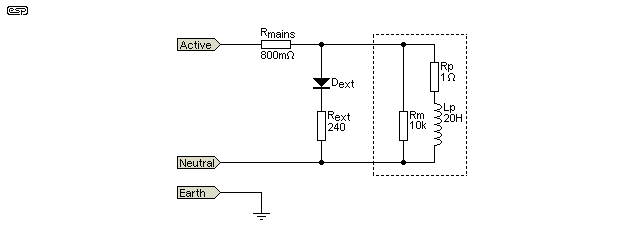
Figure 1 - Half-Wave Rectified Appliance, Transformer & Mains Wiring
The arrangement shown above assumes that the mains has an impedance of Rmains, which varies from one house to the next. The value of 800 milliohms was chosen because this is what I measured at my workbench. Your mains may be better or worse than this. Rp and Lp are the primary resistance and primary inductance, and Rm represents the magnetising current effective resistance. This is in addition to the current drawn through the inductance (which has an impedance of 12.5k at 50Hz. The inductance of a mains transformer is not a fixed value, and I've used an estimation based on measurements (and experience).
Note that any equipment that draws current with even harmonics present will cause a DC offset. Many switchmode supplies have an awful mains current waveform, but it's symmetrical (odd harmonics only) so doesn't create an offset. Regulations in most countries limit the allowable even harmonic distortion to very low values, because it's not just your equipment that's vulnerable, but the transmission infrastructure (notably transformers) are all affected, limiting the power they can deliver without overload.
After the asymmetrical (Rext and Dext) load has done its job, a simulation shows the positive peaks of the 240V AC waveform reach 338.35V, but the (unloaded) negative peaks reach the proper value of 339.28V. This is a tiny bit less than the theoretical value of 339.41V because of the transformer load resistance and simulator resolution. The difference between the peak voltages is 0.93V, but the mean (average) DC voltage is -275mV. It is the mean value that appears as 'DC' on the mains. It can also be measured, but to do so requires that one works on live components. This is not recommended as it is inherently dangerous.
However, if you must (and PLEASE take extreme care), you need a 100k resistor and a 10µF non-polarised capacitor, wired in series. Connect this circuit across the mains (power off!), and connect a DC voltmeter across the capacitor. This attenuates the AC enough to prevent the front-end of the meter from being overloaded, and the DC voltage is easy to measure. Expect to see the DC vary around the zero voltage, with a normal variation of ±25mV or so (typical - residential areas). The alternative method is to measure the DC across the diode/capacitor network in the circuit of Figure 3. Do not connect or disconnect the meter with the circuit live, and use insulated alligator clip leads to make the connections.
With a half wave rectified load, the mean DC level is 318mV as described above - polarity is not important, because either polarity will be as bad as the other. If a transformer has a primary DC resistance of 2 ohms, there will be an effective DC current of 159mA in the primary. This is many times the current needed to cause the core to saturate during the negative half cycle of the AC waveform. Remember that with a toroidal core, saturation is a 'hard limit'. Because there is no air gap (intentional or otherwise), when the saturation limit is reached, inductance falls and current rises rapidly.
Tests were done using a 500VA toroidal transformer with very close to the example values given above. With 240V AC mains, 50Hz, 264mV DC offset created by DC injection (see Figure 6), and at no load, the current was seen to rise from 16mA to 218mA. The test was done at no load because this is the worst possible case. As load increases, the effective primary voltage falls - the voltage dropped across the winding's resistance is 'lost' to the transformer. 264mV DC offset causes a current of 132mA DC in the transformer primary. This is probably close to the maximum offset that you will encounter in real life, although some areas may be worse. I have no data on this. Measurements taken in my workshop show 'typical' offsets of between 3 and 8mV.
Note that all current measurements must be made using a true RMS meter. All 'normal' (not using a true RMS detector) meters use an average responding circuit, and this will cause serious errors because the waveforms are not sinewaves. Waveform distortion creates large errors with 'ordinary' meters.
The full set of measurements is shown in Table 1.
| Parameter | No DC | With 132mA DC |
| Primary Resistance | 2 Ohms | |
| Magnetising Current RMS | 15.7 mA | 218 mA |
| Magnetising Current P-P | 50 mA | 1 A |
| Secondary Voltage | 31.8 V RMS | 31 V RMS |
| No-Load VA | 3.77 VA | 52.32 VA |
| Primary Impedance | 15.3 k | 1.1 k |
| Effective Inductance | 48.7 H | 3.5 H |
The current waveforms are shown below. These were taken from the mains input to the transformer, using an in-line current monitor. The waveforms were captured using a PC based oscilloscope, and RMS currents in Table 1 were measured using a Tektronix digital oscilloscope.
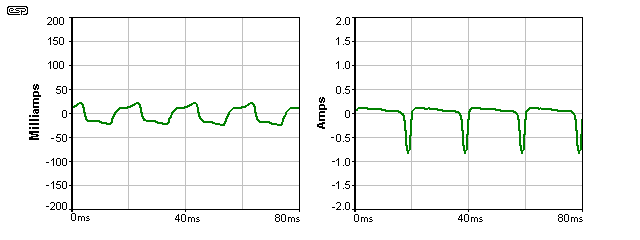
Figure 2 - Transformer Idle Current
The normal idle current is shown on the left, and the current with 132mA DC offset is on the right. The asymmetrical waveform with DC present is very obvious - the current is drawn predominantly during the negative half-cycles. If the DC polarity were to be reversed, the positive half-cycles will create saturation. Note that the right current scale is 10 times that on the left.
As you can see, the normal idle current is not a sinewave. The small peaks at the right side of the half-cycles become larger as the transformer is pushed further towards saturation, indicating that the transformer is just on the verge of saturation in normal operation. This is deliberate. If a transformer is built using enough primary turns to ensure that no saturation effects are visible, it will have very poor regulation because the primary resistance will be too high.
Like so many things in electronics, transformer winding is a balancing act. There are many compromises - more turns lowers the core flux, but increases winding resistance, reducing regulation. Fewer turns gives better regulation, but the transformer will run hot at no-load and even a small over-voltage (or DC offset) will cause even higher no-load current.
Logically, using a series capacitor will block any DC. Capacitors cannot pass DC, so the waveform will re-centre itself to ensure that there is no offset. This happens regardless of how the DC offset was created, and it's insensitive to waveform distortion. It's only when we do a few calculations that the real problem shows itself. Naturally, we want the lowest possible voltage to appear across the capacitor. We also want to ensure that a series resonant effect is not created where the capacitance and transformer primary inductance create a tuned circuit at (or near) the mains frequency. Such a circuit will appear as an extremely low impedance across the mains, and can generate voltages sufficient to destroy any capacitor (explosively!) and possibly the transformer winding insulation. The fuse or circuit breaker will blow, but the damage is done.
So, we need a capacitor (or a circuit) that will ...
That's a tall order! Taking each point in turn, we can look at the likely requirements ...
It may seem that we need to know the amplifier power rating, and also that of the transformer. We already know that the transformer will be subjected to considerable inrush current, both to set up the magnetising current and initially charge the filter caps. At this point, use of a soft start circuit (see Project 39) is highly recommended.
For the sake of the exercise, we'll use the 500VA transformer as shown in Table 1. Maximum long-term input current is ...
I = VA / V = 500 / 240 = 2.08A
From the DC perspective, the most critical region is at no-load. The saturation effects are greatly reduced when we are drawing significant current, so we will hopefully be able to simplify the circuit. However, it would be non-sensible to use caps with a ripple current rating of less than (at least) a couple of amps. The suggested 4,700µF caps will typically have a ripple current rating of between 3 and 5A, and that's normally quite sufficient. Remember that when the transformer is pulling high current from the mains, the diodes (or preferably high current bridge rectifier) pass the majority of the peak current, and the caps won't be subjected to a particularly high current. Because music has transients, the average ripple current will typically be less than 2A, but that can be exceeded for short periods.
Now that we have the current, we can work out the required capacitance. Keeping the RMS voltage across the capacitor below 1V would seem like a reasonable figure, and I'd suggest that the maximum current of interest is around ¼ (25%) of the full load current - about 500mA. We can do this with power amps, because they don't draw full power continuously. For preamps or Class-A power amps, the current does not vary, so the capacitance must be sufficient to support the full mains current in normal operation. In reality, when most transformers are run at close to their maximum rating, DC offset usually doesn't cause problems, and a blocker is generally not necessary. Small transformers used for preamps are affected by DC offset, but the effects are rarely audible due to the much higher primary resistance.
If the 25% 'rule' is applied, this means that capacitive reactance must be 2 Ohms or less. Remember that we can use Ohm's law to make these calculations - at least up to this point. Calculating the capacitance needed means that we use the capacitive reactance formula, suitably rearranged ...
C = 1 / ( 2π × f × Xc ) where f is frequency and Xc is capacitive reactance
C = 1 / ( 2π × 50 × 2 ) = 1,590µF
That's a fairly large capacitance, and can only be economically realised using an electrolytic capacitor. This raises a new quandary - electrolytic caps can operate for many years without a polarising voltage, but only at very low voltages. This means that the maximum voltage across the cap(s) must be limited to less than 1V, or they will fail. To be sensible, it will be necessary to use a pair of electrolytic capacitors, wired in 'anti-parallel'. However, in this configuration it may be impossible to keep the voltage across each capacitor low enough to prevent eventual failure. A normal series connection with the two negative (or positive) terminals joined will work, but reduces the available capacitance and maximises ripple current through both caps. Nonetheless, this is preferable (see conclusion). The traditional way to limit the voltage is to use a number of high current diodes in parallel with the caps.
The 1,500µF figure is flexible, and my suggestion is to use a pair of 4,700µF caps in series (2,350µF nominal), which will work well in the majority of systems without any need to mess around with calculations. Excessive capacitance may be as bad as too little, because the charging time is so long that many of the DC 'events' may not last long enough for the caps to charge and remove the DC component.
The primary inductance can be calculated (close enough) by knowing the no-load current. All the primary current at no-load is the result of magnetising loss, and this is nothing more than that current which is drawn by an inductor when connected to the mains supply. The approximate effective inductance can be calculated, and it will generally be in the order of 40H or more. To save anyone the trouble, we have already determined that we need about 1,500µF, so series resonance can be discounted. The amount of capacitance is simply far too large to be able to resonate at 50Hz (or 60Hz) unless the transformer's inductance is impossibly small. However, it's still worth checking!
f = 1 / ( 2π × √( L × C )) where f is frequency, L is inductance and C is capacitance
f = 1 / ( 2π × √( 40 × 1,500µ ) = 0.649 Hz
The resonant frequency of the network is well away from the mains frequency, so series resonance is not a problem.
Inrush current can be very much higher than the nominal full power current, so the capacitor(s) require protection against over-current. The simplest has already been mentioned - the diodes that limit the maximum voltage across the caps will also limit the capacitor current. As current increases, so too does the voltage across the capacitors. The diodes will conduct if the voltage exceeds the forward voltage of either pair of the two series diodes. These diodes must be capable of withstanding the maximum peak current expected. This may exceed 50A for a brief period, and again, use a soft-start circuit!
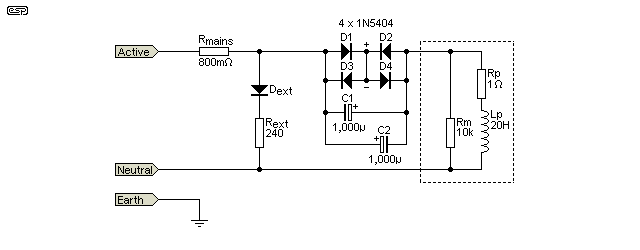
Figure 3 - Basic DC Stopper Circuit
The circuit shown above satisfies all criteria. There is more than enough capacitance, and the diodes specified have a continuous current rating of 3A and a peak current rating of 200A (non-repetitive). After this circuit is included, the no-load current falls back to 16mA, and the visible signs of asymmetrical saturation are gone. As transformer load increases, the diodes will take over from the caps, preventing the peak voltage across either capacitor from exceeding 1.3V - even during the inrush current period.
While the circuit is shown connected in the active (live) line, it makes no difference whether it's in the active or neutral. This also applies to electrical safety - all electrical codes classify the neutral as a hazardous conductor, because there are so many way that active and neutral can be reversed. The same level of insulation is required regardless of where the circuit is placed electrically, and any claim you see that it's somehow 'safer' in the neutral line is simply untrue. In theory it's true, but in reality active and neutral are classified as being equally dangerous.
Note that if no soft-start circuit is used, larger diodes are highly recommended. Regardless of whether soft-start is used or not, a 25A or 35A bridge rectifier assembly is a simple and relatively inexpensive way to obtain very high current diodes, already neatly packaged and insulated. When using a bridge, remember that + and - must be shorted together to obtain 4 diodes in anti-parallel (as shown in Figure 3).
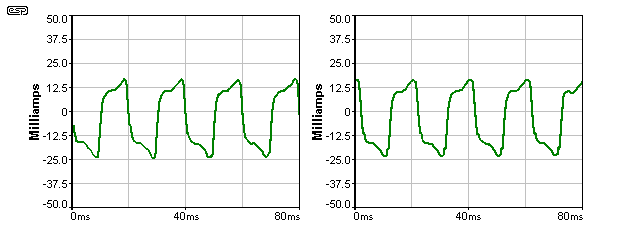
Figure 4 - Transformer No-Load Current With Stopper Installed
After installing the DC Stopper in circuit with the same transformer as used above, the above shows the current without DC (left) and with DC (right). The plots are almost identical. What is not seen is a very low frequency oscillation after the DC is switched in or out. This is caused by the series resonant circuit mentioned above. While it looks a little disconcerting, it's nothing to worry about and can be ignored. Frequency is as calculated - approximately 0.6Hz (more on this topic below).
The situation becomes somewhat less clear when we look at the typical current waveform as seen at the primary of a transformer feeding a capacitor input filter (99.99% of all transistor amplifiers use a capacitor input filter). We are not in any position to try to remove DC offset at all power levels - the capacitance needed simply becomes too large. Therefore, at some value of current, the voltage across the capacitor will be such that the diodes conduct. Even without exceeding the transformer's continuous rating, the peak current drawn by a 500VA transformer can exceed 5.5 Amps. This is shown in Figure 5. A large number of amplifiers (including very expensive commercial brands) will cause the transformer to be overloaded if both channels are driven to full power simultaneously. This is perfectly alright - transformers can withstand huge short-term overloads provided the average VA rating is not exceeded long term.
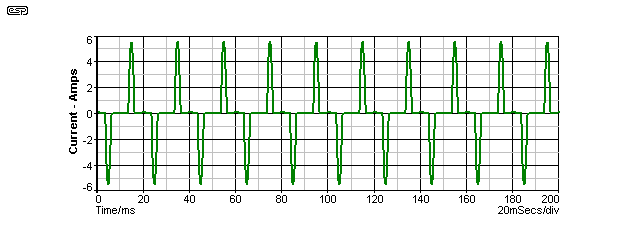
Figure 5 - Current Waveform at Full Power
If the 500VA transformer is driven to full power (RMS current for the waveform shown is 2.06A), the ripple current through the capacitors will be the same as the transformer's current draw, but we determined the capacitance based on light loading. With 5.5A peaks, even high current diodes can be expected to have a forward voltage of at least 1V, and considerably more during the power-on inrush period.
The capacitors need to be able to handle the maximum worst case current. For the sake of the exercise, it is worthwhile to size the caps so that they are capable of handling the full load current - 2A. On this basis, it is better to select a much higher voltage than needed to ensure that the ripple current rating is high enough. Although 16V caps would seem perfectly alright, 63V caps will have a ripple current rating that's more than double that of the low voltage type. The extra size helps to keep the cap cool, improving life expectancy.
Allowable capacitor ripple current is dependent on one primary criterion - the physical size of the component (all other things being equal). A physically small cap has a small surface area, so is unable to dissipate heat. Heat is generated by the combination of the capacitor's ESR (equivalent series resistance) and current ( P = I² × R ), and small caps also have comparatively high ESR. With a small surface area, it's not difficult to cause overheating and subsequent failure.
The method for DC injection shown above (a half wave rectified load), while quite realistic, has the disadvantage of being somewhat uncontrolled. In addition, I don't have any hot air blowers that use a diode for half power, so the test used was somewhat different from the description. Instead of the half-wave load, I used a small power supply, and actually injected DC in series with the incoming mains. The test setup is shown in Figure 6, and it allowed me to have complete control over the parameters during the tests. The arrangement shown provides about 226mV DC offset, probably more than most installations will ever experience.
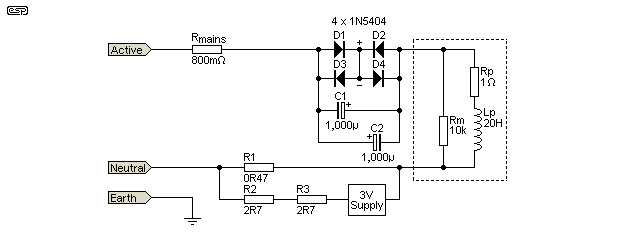
Figure 6 - Test Circuit Used
The circuit shown above should not be used unless you are absolutely sure of your ability to take fully isolated measurements, and are fully aware of the serious risk to life if you get something wrong. It can (and will) kill you if you touch anything!
The arrangement above was used to produce the waveforms shown in Figures 2 and 4. It was also used to check if any variations of the DC stopper circuit would work. The benefit of doing the test as shown is that the amount of DC is easily varied, and no external high power load was needed while the test was running. The disadvantage (and it's a serious one) is that everything is at mains voltage. Never assume that the neutral is 'safe' - it isn't, and that's why all wiring codes insist that it be treated as a live conductor.
While the method used does not cause waveform asymmetry, neither the mains nor the DC stopper circuit actually care if the waveform is asymmetrical or not. Either direct DC injection or an asymmetrical waveform cause an effective DC voltage to exist, and that's all that needs to be tested. With the stopper in circuit, the normal magnetising current cycling behaviour seen went away. These cycles occur naturally, and cause (usually) slight saturation effects to become visible on the positive half cycle, then the negative, then back again. Even a doubling of the peak to peak magnetising current (from 50mA to 100mA) will cause many toroidal transformers to growl quietly. As seen from the above, as little as 137mA of DC will cause the quiescent VA to rise from 3.7VA to over 50VA, and that's with zero secondary load.
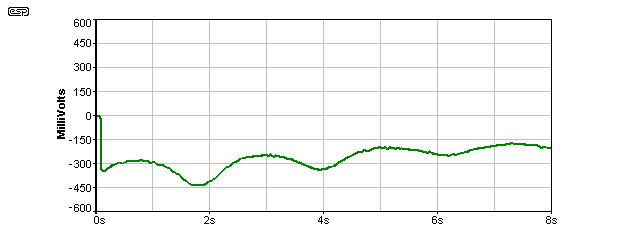
Figure 7 - Series Resonance Effects
It's worth showing the effect of series resonance between the capacitor and transformer's primary inductance. The above graph shows the behaviour after the application of DC. The period between peaks is 2.12 seconds, which makes the frequency 0.47Hz. A calculation using 2,000µF and an estimated 40H gives 0.56Hz, and the figures are close enough to see that the effect is real.
Figure 8 shows the final (and recommended) design. While electrolytic caps can withstand a small reverse voltage (around 1V is typical), in the interests of longevity it is probably better to use the caps in series. Being in series, the capacitance of each must be doubled, and as shown the total effective capacitance is 2,350µF. Larger electrolytics can be used if desired, and a medium voltage rating will be required to ensure they can withstand the ripple current (this must be verified! ). Make sure the caps are well clear of anything that gets hot in operation.
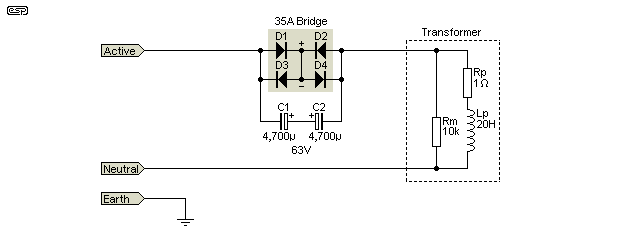
Figure 8 - Recommended Design
While it is probable that using the caps in parallel as shown earlier will work reliably for many years, this is not something I can guarantee, because I've not performed any form of accelerated ageing process to the circuit. Not having used the circuit in any of my own equipment, I have no data either way. Ideally, the individual diodes will be replaced by a 25-35A chassis-mount bridge rectifier. This ensures that peak current (inrush and at full load) is accommodated with safety, even with high powered amplifiers. In some cases it may be necessary to use two bridges in series (both with the +ve and -ve terminals shorted together).
Note: You can now buy 'Conductive Polymer Aluminum Solid Electrolytic Capacitors' from a number of vendors, which offer very high ripple current ratings for low-voltage caps. One I've seen can handle 5A ripple current for a 10V, 1,000μF (1mF) cap, with an ESR of 13mΩ, measuring only 10 x 12mm and costing less than AU$1.00 at the time of writing (2025). You may need to use a few of them to get the capacitance you need, but they are small and cheap, and allow for a lot of capacitance with a sensible size and cost. Ten of them will cost less than one 'traditional' aluminium electro with the same ripple current rating. However, the ripple current must be reduced at frequencies below 100kHz (it's only 250mA at 120Hz, so maybe 200mA max. at 50Hz!)
The circuit and design processes described here will work for any size transformer. In most cases, the circuit shown in Figure 8 will be fine for any transformer from 500 to 750VA. DC stoppers are usually not needed in smaller toroidal trannies because their primary DC resistance is high enough to limit the (usually small) DC component so the DC has very little effect.
There is something to be said for the use of only two diodes in reverse-parallel, combined with larger capacitance (double the amount shown here). Voltages are lower, but the larger capacitors will be physically smaller because lower voltage parts can be used as ripple current is reduced. The critical component is the capacitor - that is the key to blocking DC.
It has been suggested elsewhere* that diodes have a forward voltage, and that is sufficient to block the DC component of the mains waveform. This is perfectly true for a low DC voltage by itself, but not with AC present at the same time. I tested the circuit using diodes alone and it does ... exactly nothing. The diodes are used to protect the capacitor bank, but it is the capacitor that blocks the DC - not the diodes. While the circuit may work with a small capacitance, it still has to be large enough to ensure that the normal idle current of the transformer cannot create a voltage drop such that the diodes conduct. The smallest capacitance that could be used with the circuit shown above is probably about 440µF (2 x 220µF caps in anti-parallel) or 500µF (2 x 1,000µF caps in opposed series [positive to positive]), but this will be marginal. The caps may be unable to withstand the ripple current by the time the diodes conduct, and overall effectiveness is seriously diminished.
* Note - There is a thread covering this on the DIY Audio site, and a reference to that in the ESP forum. It was these that got me thinking that the technique is apparently not well understood, and that few (if any) DIY enthusiasts have performed serious tests on the various combinations referred to. This article is due to the forum posts and the obvious misunderstandings therein, that will usually result in a circuit that may be unreliable, or may not actually achieve anything useful.
Additional tests I performed used only diodes (no effect whatsoever), and a 22µF and 1µF capacitor, and both of these were completely useless. Actually, they were worse than useless, by actually creating a DC offset! Without a very detailed examination, it appears that the small capacitance is only capable of averaging the slightly different forward voltages of the diodes, resulting in a few millivolts of offset. Because the cap is not big enough to maintain the AC component to a value well below diode conduction voltage, this small DC voltage then becomes an offset. With 1µF, transformer idle current rose to about 25mA without any external DC, and was 170mA when DC was added (same setup as used for all other tests). Idle current was a little less than this with the 22µF cap, but not by very much.
It's worth noting that the mains 'DC' observed (measured across the diode/capacitor network) varied by about ±25mV worst case - at least while I was watching!. However, this was measured in a residential area, and there is no doubt that much higher voltages occur from time to time. I expect that a circuit that has been tested to work with over 250mV as shown here will be more than sufficient for most installations.
The circuit as shown will also work perfectly with 120V 60Hz, but it would be wise to increase the capacitance (double the value shown here). Although the caps will work better with the higher frequency, the transformer idle current will be higher than that of a 220-240V transformer.

| Note that for (e.g. valve) amps and preamps and other devices that draw the maximum current continuously, you cannot (and must not) assume that the capacitance needed can be reduced. With a continuous current, the capacitance needs to be large enough to support the continuous current. As before, inrush current is not a problem, and the diodes will conduct during that period. It's extremely important that the diodes do not conduct during normal operation, or the DC blocking is compromised. In general, most amps that operate at a continuous high current will not require a DC blocker, because the load current tends to mitigate the effects of DC offset. |
There are many misconceptions about the use of DC blockers, with some self-proclaimed 'experts' insisting that they are snake oil, because DC can't get through the mains distribution transformers. This shows a complete lack of understanding of mains distribution, how offset can be created, and just how little DC offset is necessary to cause problems with large toroidal transformers. This is not something that I just dreamed up - I've been able to measure DC offset, and as described above, a hair dryer that uses a diode for 'half-power' can be enough to cause a large toroidal transformer to blow the mains fuse or even the switchboard circuit breaker!
Likewise, I can't bear to hear/ read actual snake oil vendors claiming that you'll get "cleaner highs", "more authority in the bass" or any of the other stupid things you may read elsewhere. The purpose is to stop transformers from growling (usually at no or light load). There is no magic, and it doesn't improve anything other than reduce the acoustic noise from the transformer(s). Anyone who claims otherwise is probably lying.
You need to add a DC blocker only if you can hear power transformers growling intermittently when the amps are running but with no (or very low) power output. Adding one will not 'improve' the sound, it's purely a preventative measure that ensures that mains DC offsets don't cause audible (mechanical) noise. This isn't a panacea, but if you do have issues then it's a reasonably cheap (and effective) way to minimise the transformer noise. There may be cases where the DC blocker may not be effective (transformers can also growl if the mains voltage is higher than normal).
Electrical safety is of utmost importance with a circuit such as that described here. Never rely on the electrolytic capacitor outer plastic sleeve for insulation. All parts must be meticulously mounted, with special consideration to personal protection from live components and separation of all low voltage conductors from anything at mains potential.
Ideally, the entire circuit will be afforded an earthed metal cover plate. This protects against accidental contact, and ensures that should a capacitor choose to explode, it's intestines will be confined to a small area, rather than scattered throughout the amplifier chassis.
Regardless of whether the circuit is installed in the active (live) or neutral conductor, the insulation requirements do not change. There is no guarantee that the neutral will always be at earth potential. An incorrectly wired mains lead, power board, extension lead or power outlet can all make the active become the neutral and vice versa. Because of this, you must allow for the worst case and insulate accordingly.
While testing your new DC Blocker, you must use insulated alligator clip leads for your multimeter. All connections must be made with power off. The clip leads allow you to make connections that don't rely on you holding probes in position. A slip can cause a lot of damage!.
If at all possible, use a Variac to power the circuit for the first time. This allows you to monitor everything and power can be removed before any damage is done if you made a mistake. If a Variac is not available, use a 100W incandescent lamp in series with the mains lead. Ideally, the secondary windings of the transformer should be disconnected while you are testing. Likewise, insulation between active (live) and neutral to earth/ ground should be checked with a high voltage insulation tester if you can. Not many hobbyists will have one available, but if you do, use it.
 Main Index
Main Index
 Articles Index
Articles Index